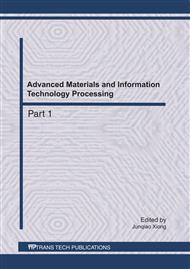[1]
MacBeth. Colin, HajNasser. Yesser, Stephen. Karl, Gardiner. Andy: Exploring the effect of meso-scale shale beds on a reservoir's overall stress sensitivity to seismic waves, Geophysical Prospecting, Volume. 59, No. 1, pp.90-110, (2011).
DOI: 10.1111/j.1365-2478.2010.00897.x
Google Scholar
[2]
Tsvankin. Ilya, Gaiser. James, Grechka. Vladimir, Van der. Baan. Mirko, Thomsen. Leon: Seismic anisotropy in exploration and reservoir characterization: An overview, Geophysics, Volume. 75, No. 5, pp. 75A15-75A29, (2010).
DOI: 10.1190/1.3481775
Google Scholar
[3]
Y-S. Hu, R-L. Qi, Y-R. Wei, G-L. Wang: Seismic evidence of strike-slip faults in the middle of Fangzheng rift and favorable exploration areas, Jilin Daxue Xuebao (Diqiu Kexue Ban)/Journal of Jilin University (Earth Science Edition), Volume. 40, No. 6, pp.1271-1277, (2010).
Google Scholar
[4]
Macmillan. Susan, Grindrod. Steve: Confidence limits associated with values of the earth's magnetic field used for directional drilling, SPE Drilling and Completion, Volume. 25, No. 2, pp.230-238, ( 2010).
DOI: 10.2118/119851-pa
Google Scholar
[5]
Vallée. Marc A., Smith. Richard S., Keating. Pierre: Case history of combined airborne time-domain electromagnetics and power-line field survey in Chibougamau, Canada, Geophysics, Volume. 75, No. 2, pp. B67-B72, (2010).
DOI: 10.1190/1.3343573
Google Scholar
[6]
Suzuki. Koichi, Oyama. Takahiro, Kawashima. Fumiharu, Tsukada. Tomoyuki, Jyomori. Akira: Monitoring of grout material injected under a reservoir using electrical and electromagnetic surveys, Exploration Geophysics, Volume. 41, No. 1, pp.69-79, (2010).
DOI: 10.1071/eg09051
Google Scholar
[7]
Q. Zhu, H. Lin, Doolittle, James: Repeated electromagnetic induction surveys for improved soil mapping in an agricultural landscape, Soil Science Society of America Journal, Volume. 74, No. 5, pp.1763-1774, (2010).
DOI: 10.2136/sssaj2010.0056
Google Scholar
[8]
Duarte. Pedro, Mateus. António, Paiva. Isabel, Trindade. Romão, Santos. Pedro: Usefulness of systematic in situ gamma-ray surveys in the radiometric characterization of natural systems with poorly contrasting geological features (examples from NE of Portugal), Applied Radiation and Isotopes, Volume. 69, No. 2, pp.463-474, (2011).
DOI: 10.1016/j.apradiso.2010.10.002
Google Scholar
[9]
S-H. Meng,F. Qi, H-B. Chen,Z. Wang, G-H. Bai: The repeated thermal shock behaviors of a ZrB2-SiC composite heated by electric resistance method, "International Journal of Refractory Metals and Hard Materials, Volume. 29, No. 1, pp.44-48, (2011).
DOI: 10.1016/j.ijrmhm.2010.06.012
Google Scholar
[10]
J-L. Zhong, J-J. Wang, B. Zhang, R. Zeng, J-L. He: Grounding resistance measurement by angle-offset method for urban substations, Dianwang Jishu/Power System Technology, Volume. 34, No. 6, pp.34-37, ( 2010)(In Chinese).
Google Scholar
[11]
Y-H. Liu, D-Y. Wu, J-X. Wang: Ground-penetrating radar detection of the defects in tunnel lining, Advanced Materials Research, Volume. 163-167, pp.3794-3797, (2011).
DOI: 10.4028/www.scientific.net/amr.163-167.3794
Google Scholar
[12]
W.L. Lai, T. Kind, H. Wiggenhauser: Using ground penetrating radar and timefrequency analysis to characterize construction materials, NDT and E International, Volume. 44, No. 1, pp.111-120, (2011).
DOI: 10.1016/j.ndteint.2010.10.002
Google Scholar
[13]
F-Z. Kang, F-L. Qi, S-H. He,B. Jiang: Application of ground penetrating radar to disease detection of Kunlun Mountain tunnel, Yanshilixue Yu Gongcheng Xuebao/Chinese Journal of Rock Mechanics and Engineering, Volume. 29, no SUPPL. 2, pp.3641-3646, (2010).
Google Scholar
[14]
L-W. Zhang, H-F. Sun, S-C. Li, D-H. Qiu, D-Y. Zhang: Application of Ground Penetrating Radar to rock failure analysis in high risk tunnels, Applied Mechanics and Materials, Volume. 34-35, pp.1661-1665.
DOI: 10.4028/www.scientific.net/amm.34-35.1661
Google Scholar
[15]
T-B. Li, L-B. Meng,J. Zhu, Y-L. Li,L. Mou: Comprehensive analysis method for advanced forecast of geology in tunnels, Yanshilixue Yu Gongcheng Xuebao/Chinese Journal of Rock Mechanics and Engineering, Volume. 28, No. 12, pp.2429-2436, (2009).
Google Scholar
[16]
Y-G. Xue, S-C. Li, M-X. Su,X. Zhang,Y. Zhao, W-T. Li: Practice of comprehensive early-warning geological prediction on aquifer fault in Qingdao Kiaochow bay subsea tunnel, Yanshilixue Yu Gongcheng Xuebao/Chinese Journal of Rock Mechanics and Engineering, Volume. 28, No. 10, pp.2081-2087, (2009).
Google Scholar


